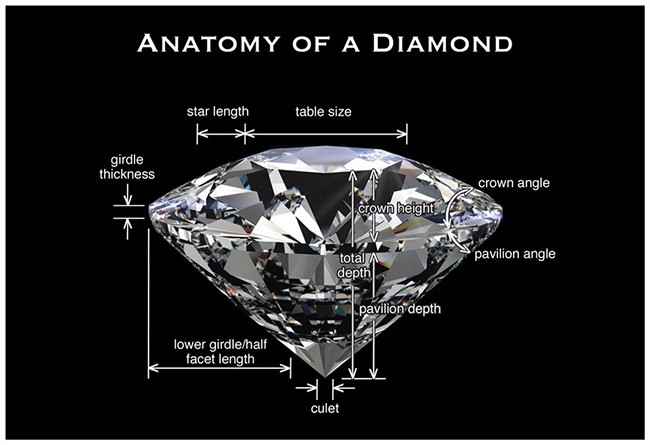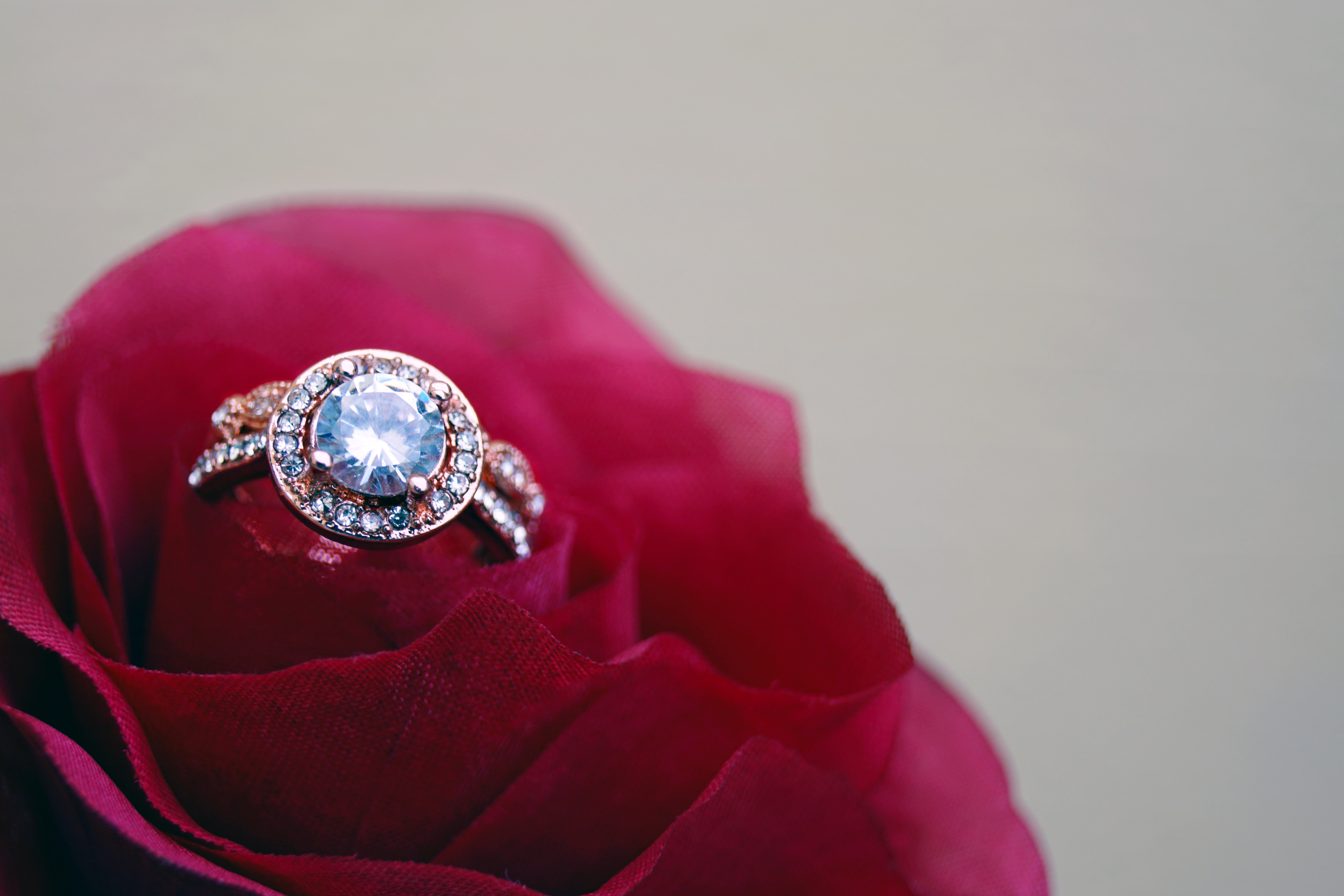Anatomy of a Diamond
If you thought anatomy was just relevant for medical students, think again. When it comes to picking the perfect jewel, symmetry and proportion are everything. The complete picture of all the “4 C’s” (carat, color, cut, and clarity) is the most important element in choosing an anatomically perfect diamond.
A trained diamond cutter will know exactly how to cut each diamond to maximize the potential and bring out the beauty.
- If cut too shallow, light will escape to the side, creating a dull-looking diamond. A deep cut, on the other hand, won’t allow the right amount of light to reflect back through.
- A deep cut will also produce a diamond that lacks brightness.
- An ideal cut, though, will be perfectly balanced, where each side or facet is symmetrical, the proportions match, and all parts of the diamond are cut in a way that lets the light perfectly reflect throughout.
A Quick Tip:
A diamond’s ideal brilliance, sparkle and fire come from the proportion, so choosing the right jewelry designer is very important. In this instance, less is more.
A facet refers to the flat surface area that can be found on each part of the diamond. The more facets your diamond has, has no bearing on the quality but knowing your diamonds’ anatomy will assist you tremendously in choosing a great design and jeweler and of course picking the perfect diamond.
There are 5 main components of a diamond. They are referred to as; the table, crown, girdle, pavilion, and culet, respectively. It is so important that a buyer knows about each of these parts and what makes an ideal diamond. The slightest variation and you can end up buying a diamond that is weak, dull or above price point because one component has been cut too thick.
The Table:
This face or table is usually what most people notice first about a diamond. It resembles a tabletop and has a flat surface area. This makes it the largest facet on your diamond as its the top section of your jewel. The table is an essential part of your diamond, as light enters and exits through the table, determining its brilliance. Too large and the upper facets of the crown won’t have room to refract, too small and very little light can get in.
Here is some math to consider when choosing your diamond. Since the table is so important, picking the right ratio will have a great impact on the look and light of your diamond. The equation is table width divided by the total width. This will give you a percentage, called the table percentage.
When looking for the perfect diamond, the ideal table percentage will vary because of the different shapes. For example, a round-cut diamonds table should be between 54-60% and emerald-cut should be in the high 60’s to 70% range.
The Crown:
Extending below the table is the crown. If you were to view a diamond from the side, you could make out the various types of facets that comprise the crown. It is also the layer between the table and girdle. Due to its visibility, it is also the most likely area to get scratches. In almost every setting the crown sits right above the prongs that hold the jewel in place. In addition, the crown is where you can see the brilliant and step facets (brilliant facets are round and steps are parallel)
The crown has four different diamond facets. The table (which is described above), the star facets, kite facets, and the upper girdle facets. For example, a diamond that has a beautiful 8-pointed star look will have eight-star facets that are shaped like triangles and situated around the table. Kite facets, also referred to as bezels are shaped like a kite with four sides.
Fancy Cut diamonds, which refer to all cuts other than the round brilliant, each have a different number of facets. Round, Marquise, Pear-Shape, and Oval have 33 facets on the crown. Emerald and radiant cuts have 25 and a princess cut should have 21 on the crown.
The Girdle:
This is the widest area of a diamond (appears as a perimeter around your jewel) found on the outer edge. This is a very important piece of the diamond’s anatomy. A thin girdle will affect the strength of the piece. Perhaps, more importantly, a girdle that is too thick will be lackluster and even more disconcerting will add weight and cost. Just the right thickness will support the diamond well. Contact a diamond expert to check your diamond’s girdle as the price can be lowered for any of these disproportions.
The girdle can be polished, faceted or left rough. Below the above-mentioned bezel, facets are 16 triangle facets called the upper girdle facets.
The Pavilion:
The diamond pavilion is found at the bottom of your stone. It is situated opposite the crown and typically is the longest section of the diamond itself (except in an emerald or rectangular shape). The setting prongs typically hide part of the pavilion, so a talented designer will try to minimize the pavilion to allow light to pass through. The more light that can enter, the more brilliance can be achieved.
A brilliant, or round cut diamond, with triangular facets, will have a faceted girdle instead of round. This gives the diamond more transparency. Step cut, on the other hand, will usually have polished girdles.
The ideal pavilion will bounce light from one side to the other sending it back through the table for that awe-inspiring brilliance we all love. For the pavilion, depth, facets, and cut will all determine if your diamond has been perfectly crafted.
The Culet:
Last but certainly not least, the culet is the smallest facet albeit the most important. As mentioned the right proportion and symmetry can make or break your diamond. How the light enters and refracts is essential to choosing a beautiful perfectly cut piece. The culet must be quite small to allow the light to properly refract. If a culet is too large it will appear like a dark mark or even a hole. Sometimes a culet is absent, also referred to as a pointed culet, In this case, the pavilion comes to a point which isn’t necessarily an issue.
A diamond’s grade is also based on the overall depth of the jewel from the table to the culet. The percentage for depth is calculated by dividing the diamond’s depth by its width. This percentage will determine the diamond's proportions and therefore its ability to refract light.
The GIA has an official range of culet, rated from None to Extremely Large.
The full range as listed by the GIA, is as follows:
None (Pointed), Very Small, Small: This is the ideal, but extreme care should be taken when setting the stone.
Medium: This won’t chip but it will affect the appearance.
Slightly Large, Large: May have an effect on the diamond’s appearance
Very Large: Usually will affect the appearance
Extremely Large: highly visible with a direct impact on the appearance
As can be seen, a small culet is the best choice unless you are partial to vintage designs. A small or extremely large culet may be rated in percentages. (1.5% to 15%)
Overall, understanding and knowing all of the terminology gives you a better understanding of diamond certification. Make sure your piece is certified by an accepted and recognized organization. GIA (Gemological Institute of America) is considered the gold standard for all gems. They even inscribe gems with an inscription of the diamond’s report number.
Also, always use a trusted expert who will be able to explain each of these important details.
Image Source: laurelleantiquejewellery.com







